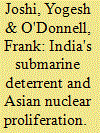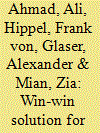|
|
|
Sort Order |
|
|
|
Items / Page
|
|
|
|
|
|
|
| Srl | Item |
| 1 |
ID:
132474


|
|
|
|
|
| Publication |
2014.
|
| Summary/Abstract |
New Delhi's plans for nuclear-armed submarines could undermine efforts to restrict fissile materials, and set off a naval arms race.
India has become a more or less accepted member of the global nuclear order, but the state's emerging undersea deterrent continues to be a source of concern. Its efforts to create nuclear-armed submarines began in the 1980s, and technical progress was slow during the project's first three decades. India has recently made some bold strides, however, and in 2009 unveiled its first nuclear submarine, INS Arihant. The boat is now undergoing sea trials, and is scheduled to be introduced into the Indian Navy by early 2015. Several similar vessels are under construction: New Delhi plans to field a fleet of between four and six nuclear-armed submarines by the end of the decade.
|
|
|
|
|
|
|
|
|
|
|
|
|
|
|
|
| 2 |
ID:
127857


|
|
|
|
|
| Publication |
2013.
|
| Summary/Abstract |
In February 1993, Russia and the United States signed an agreement on the disposition of highly enriched uranium (HEU) extracted from Russian nuclear weapons.[1] Under the terms of the deal, Russia undertook to down-blend 500 tons[2] of HEU, enough to build 20,000 nuclear warheads, over a 20-year period. The two sides agreed that the resulting low-enriched uranium (LEU) would be used as fuel by nuclear power plants in the United States, hence the informal name of the program, "Megatons to Megawatts."
In January 1994, Russia's Techsnab-export (Tenex) and the United States Enrichment Corporation (USEC), the state-run companies authorized by their respective governments to implement the deal, signed the contract. In the U.S. case, that meant that USEC was a supplier of enriched uranium to private utilities. According to assessments made at the time, the value of the entire program was expected to reach about $12 billion.
|
|
|
|
|
|
|
|
|
|
|
|
|
|
|
|
| 3 |
ID:
130326


|
|
|
|
|
| Publication |
2014.
|
| Summary/Abstract |
In November 2013, Iran and the P5+1 group of countries (China, France, Germany, Russia, the United Kingdom, and the United States) agreed on a six-month Joint Plan of Action to enable negotiations on a final settlement to contain the proliferation risks from Iran's nuclear program. This interim agreement freezes Iran's enrichment capacity, thereby preventing a further shortening of the time Iran would require to produce weapons quantities of highly enriched uranium (HEU) if it wished.1 This enrichment capacity has expanded greatly over the years since it first came to international attention in 2002. Iran and the P5+1 also have agreed on the need to constrain Iran's option to produce plutonium for weapons using the reactor that is under construction near the city of Arak and that will be under International Atomic Energy Agency (IAEA) safeguards. Under the Joint Plan of Action, Iran has agreed to freeze the Arak reactor project for six months.2 It also has committed not to separate plutonium from spent nuclear fuel or construct a facility capable of doing so. These are important interim commitments. According to Ali Akbar Salehi, the head of the Atomic Energy Organization of Iran, the Arak reactor is intended for radioisotope production and testing of nuclear fuel and materials. In response to the P5+1 proposal that Iran scrap the Arak reactor project, Salehi stated that "we see no point stopping the work on this reactor." He has acknowledged, however, the international community's concerns about the Arak reactor and offered the possibility of design changes "in order to produce less plutonium in this reactor and in this way allay the worries and mitigate the concerns.
|
|
|
|
|
|
|
|
|
|
|
|
|
|
|
|
|
|
|
|
|